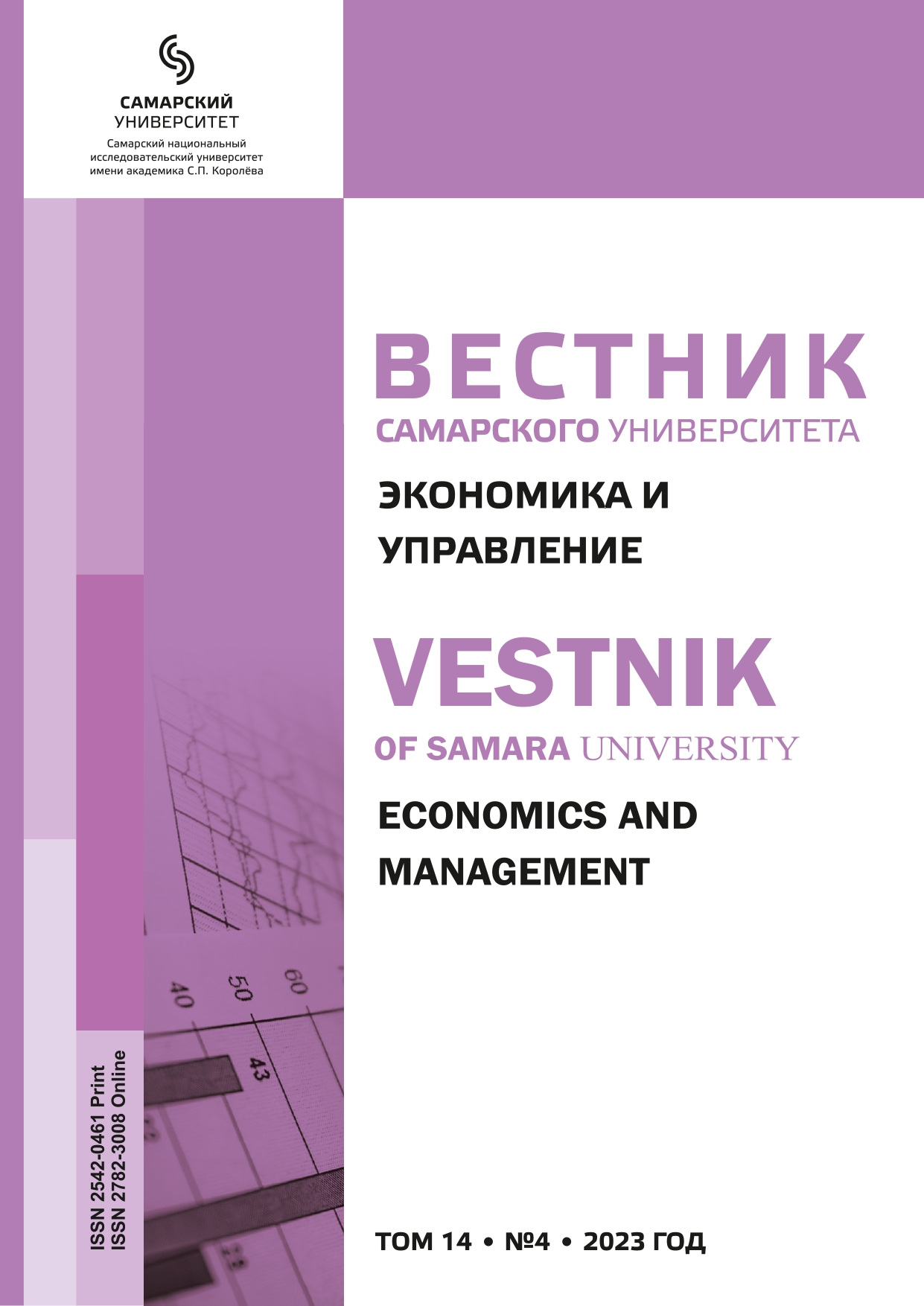Strategy for selecting optimal volumes of production activities with iterative learning
- Authors: Pavlov O.V.1
-
Affiliations:
- Samara National Research University
- Issue: Vol 14, No 4 (2023)
- Pages: 212-220
- Section: MATHEMATICAL AND INSTRUMENTAL METHODS OF ECONOMICS
- URL: https://journals.ssau.ru/eco/article/view/27180
- DOI: https://doi.org/10.18287/2542-0461-2023-14-4-212-220
- ID: 27180
Cite item
Full Text
Abstract
The problem of optimal control of production activities with iterative learning is considered. In the process of mastering new products, introducing new technologies and innovations at industrial enterprises, the effect of iterative learning is manifested, which leads to a reduction in time spent on manufacturing products while increasing the cumulative production volume. The goal of solving the problem is to reduce labor costs of industrial enterprises during the development of new products, the introduction of new technologies and innovations. The problem is formalized mathematically as a continuous-time optimal control task for a production system. The dynamics of change in the production system are described by an ordinary differential equation. Minimization of the integral growth rate of labor costs for production is considered as an optimality criterion. The original problem is reduced to the task of minimizing the integral natural logarithm of labor costs. An analytical solution to the problem is found using Pontryagin's maximum principle. A strategy for selecting optimal production volumes for any learning model has been determined. Optimal production volumes are selected in inverse proportion to the specific labor costs (labor intensity) for manufacturing products. It is shown that when choosing optimal production volumes, labor costs for manufacturing products are constant over the entire planning horizon.
About the authors
Oleg V. Pavlov
Samara National Research University
Author for correspondence.
Email: pavlov.ov@ssau.ru
ORCID iD: 0000-0003-3327-8124
Candidate of Economics, associate professor of the Department of Management
Russian Federation, 34, Moskovskoe shosse, Samara, 443086, Russian FederationReferences
- Wright T.P. Factors Affecting the Cost of Airplanes. Journal of the Aeronautical Sciences, 1936, vol. 3, no. 4, pp. 122–128. DOI: https://doi.org/10.2514/8.155.
- Badiru A. Computational survey of univariate and multivariate learning curve models. IEEE Transactions on Engineering Management, 1992, vol. 39, issue 2, pp. 176–188. DOI: https://doi.org/10.1109/17.141275.
- Yelle L.E. The learning curve: Historical review and comprehensive survey. Decision Sciences, 1979, Vol. 10, Issue 2, pp. 302–328. DOI: https://doi.org/10.1111/j.1540-5915.1979.tb00026.x.
- Learning Curves: Theory, Models, and Applications. Edited by Mohamad Y. Jaber. Boca Raton: CRC Press, 2011, 476 p. DOI: https://doi.org/10.1201/b10957.
- Novikov D.A. Patterns of iterative learning. Мoscow: IPU RAN, 1998, 77 p. Available at: http://www.methodolog.ru/books/file_37.pdf; https://www.elibrary.ru/item.asp?id=18062556. EDN: https://www.elibrary.ru/pfgvox. (In Russ.)
- Belov M.V., Novikov D.A. Technology models. Moscow: Lenand, 2019, 160 p. Available at: http://www.mtas.ru/biblio/MT.pdf; https://www.elibrary.ru/item.asp?id=39112090. EDN: https://www.elibrary.ru/bphvdq. (In Russ.)
- Belov M.V., Novikov D.A. Life cycle management of organizational and technical systems. Moscow: Lenand, 2019, 160 p. Available at: https://obuchalka.org/20200127118046/upravlenie-jiznennimi-ciklami-organizacionno-tehnicheskih-sistem-belov-m-b-novikov-d-a-2020.html; https://www.elibrary.ru/item.asp?id=41233177. EDN: https://www.elibrary.ru/hqylqr. (In Russ.)
- Belov M.V., Novikov D.A. Models of experience. Control Sciences, 2021, no. 1, p. 37–52. DOI: https://doi.org/10.25728/cs.2021.1.5. Available at: https://www.elibrary.ru/item.asp?id=47854887. EDN: https://www.elibrary.ru/leervh. (In English; original in Russian).
- Bellman R. Dynamic programming. Moscow: Izdatel'stvo inostrannoi literatury, 1960, 400 p. Available at: https://djvu.online/file/Y6aNgwIw9NxsP?ysclid=lr8z8ez7aj586852924. (In Russ.)
- Pontryagin L.S., Boltyansky V.G., Gamkrelidze R.V., Mishchenko E.F. Mathematical theory of optimal processes. 4th edition, stereotyped. Moscow: Nauka, 1983, 392 p. Available at: https://djvu.online/file/NN6TYTWzZN0kJ?ysclid=lr8zpnxous823328291. (In Russ.)
- Novikov D.A. Models of learning by doing. Large-Scale Systems Control, 2007, no. 19, pp. 5–22. Available at: https://www.elibrary.ru/download/elibrary_9592867_21020333.pdf. (In Russ.)
- Pavlov O.V., Ryasnaya T.N. Numerical solution of a production planning problem in case of dynamic labor input reduction. Vestnik of Samara State Aerospace University, 2012, no. 6 (37), pp. 126–132. Available at: https://www.elibrary.ru/download/elibrary_20419613_78336007.pdf. (In Russ.)
- Pavlov O.V. Numerical solution of the dynamic problems of planning production volumes in projects for the development of new products. Vestnik Samarskogo universiteta. Ekonomika i upravlenie Vestnik of Samara University. Economics and Management, 2017, vol. 8, no. 4, pp. 7–19. Available at: http://journals.ssau.ru/index.php/eco/article/view/5903; https://www.elibrary.ru/item.asp?id=32658516. EDN: https://www.elibrary.ru/ytfesx. (In Russ.)
- Pavlov O.V. Analytical study of the problem of planning production activities in projects for the development of new products. Economic Sciences, 2017, no. 12 (157), pp. 30–36. Available at: http://www.ecsn.ru/files/pdf/201712/201712_30.pdf; https://www.elibrary.ru/item.asp?id=32606990. EDN: https://www.elibrary.ru/lbnruv. (In Russ.)
- Pavlov O.V. Dynamic models of production planning with continuous time in projects of new products development. Journal of Physics: Conference Series, 2018, vol. 1096, p. 012180. DOI: https://doi.org/10.1088/1742-6596/1096/1/012180.
Supplementary files










